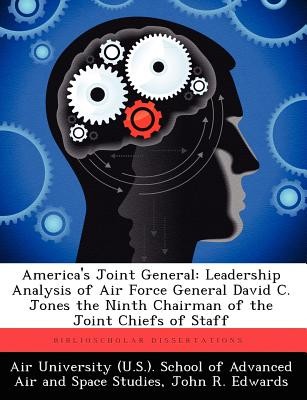
- We will send in 10–14 business days.
- Publisher: BiblioScholar
- ISBN-10: 1249415519
- ISBN-13: 9781249415510
- Format: 18.9 x 24.6 x 0.6 cm, softcover
- Language: English
- SAVE -10% with code: EXTRA
America's Joint General (e-book) (used book) | bookbook.eu
Reviews
Description
This study evaluates General David C. Jones' leadership as a commander at the tactical, operational and strategic levels using Air Force Doctrine Document (AFDD 1-1), Leadership and Force Development, as a framework for examination. At the tactical level, Jones clearly exhibited the personal leadership and leading people/teams competencies when he flew B-29's during the Korean War and later as a squadron and wing commander under both Strategic Air Command and Tactical Air Command. In his operational level positions, as Seventh Air Force Vice Commander and Second Air Force Commander, Jones again demonstrated these two competencies in addition to the leading the institution competency. In his strategic roles as Chief of Staff of the Air Force and Chairman of the Joint Chiefs of Staff, he revealed his mastery of all three competencies, while also displaying attributes not covered by the leading the institution competency. In the final analysis, Jones success resulted from both his mastery of AFDD 1-1's three competencies and his political awareness, which represents a fourth competency that currently does not exist in leadership doctrine. Political awareness includes those leadership qualities necessary to succeed at the nexus of civil-military relations. Thus, this competency serves a fourth stage, the national military level, where civilian-military relations merge, and an emphasis on jointness is critical. Achieving the often times requires increased career diversity in order to develop the broad perspective needed to thrive in the joint arena. The study concludes that while Jones' distinguished military career provides a pattern to emulate, the Air Force must conduct further studies to identify those specific leadership qualities needed for the political awareness competency. In doing so, the Air Force will improve its capability to develop future joint force leaders.
EXTRA 10 % discount with code: EXTRA
The promotion ends in 16d.19:22:32
The discount code is valid when purchasing from 10 €. Discounts do not stack.
- Publisher: BiblioScholar
- ISBN-10: 1249415519
- ISBN-13: 9781249415510
- Format: 18.9 x 24.6 x 0.6 cm, softcover
- Language: English English
This study evaluates General David C. Jones' leadership as a commander at the tactical, operational and strategic levels using Air Force Doctrine Document (AFDD 1-1), Leadership and Force Development, as a framework for examination. At the tactical level, Jones clearly exhibited the personal leadership and leading people/teams competencies when he flew B-29's during the Korean War and later as a squadron and wing commander under both Strategic Air Command and Tactical Air Command. In his operational level positions, as Seventh Air Force Vice Commander and Second Air Force Commander, Jones again demonstrated these two competencies in addition to the leading the institution competency. In his strategic roles as Chief of Staff of the Air Force and Chairman of the Joint Chiefs of Staff, he revealed his mastery of all three competencies, while also displaying attributes not covered by the leading the institution competency. In the final analysis, Jones success resulted from both his mastery of AFDD 1-1's three competencies and his political awareness, which represents a fourth competency that currently does not exist in leadership doctrine. Political awareness includes those leadership qualities necessary to succeed at the nexus of civil-military relations. Thus, this competency serves a fourth stage, the national military level, where civilian-military relations merge, and an emphasis on jointness is critical. Achieving the often times requires increased career diversity in order to develop the broad perspective needed to thrive in the joint arena. The study concludes that while Jones' distinguished military career provides a pattern to emulate, the Air Force must conduct further studies to identify those specific leadership qualities needed for the political awareness competency. In doing so, the Air Force will improve its capability to develop future joint force leaders.


Reviews